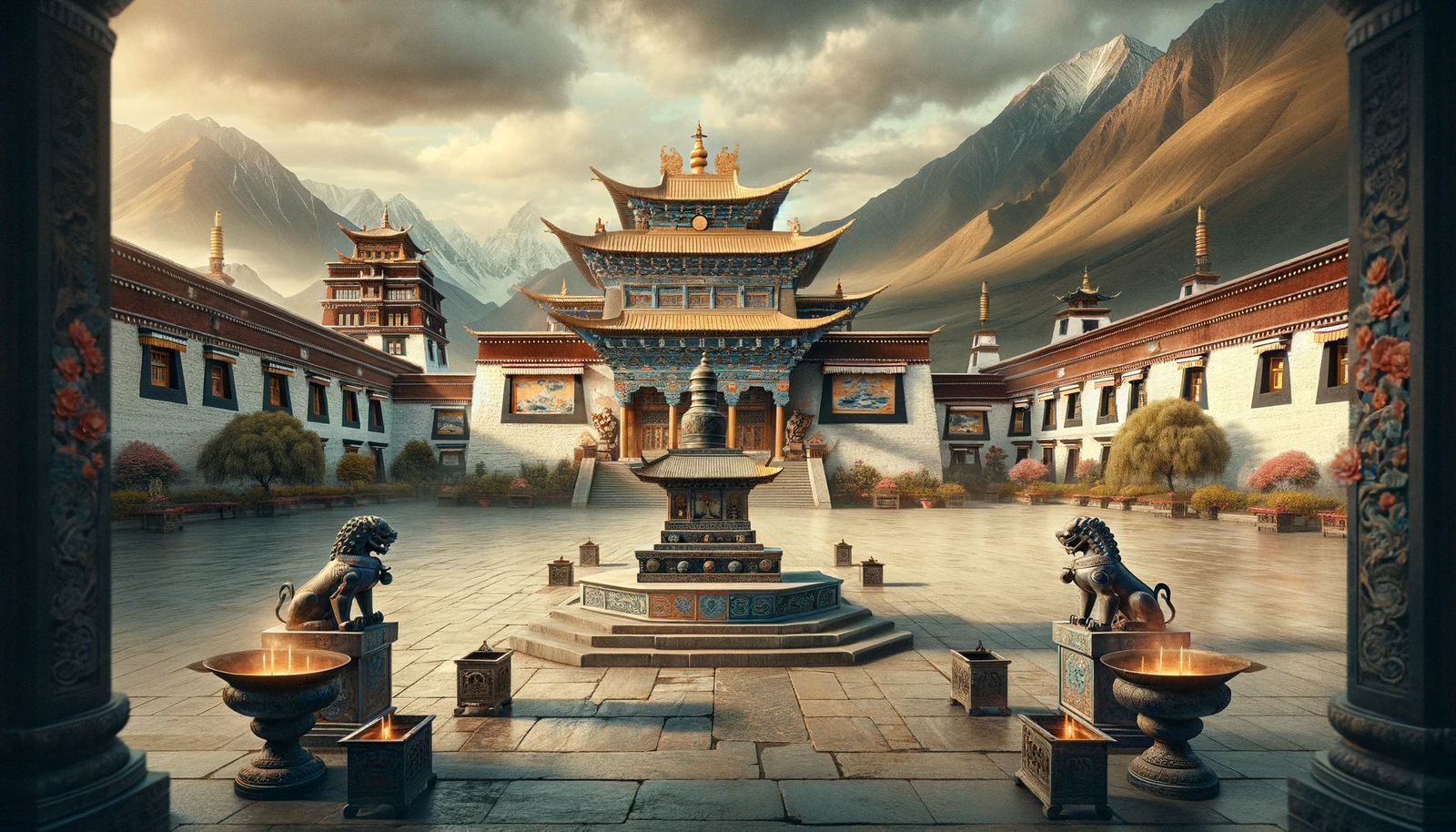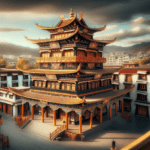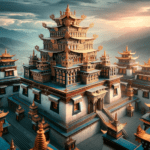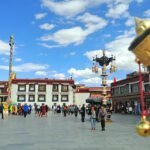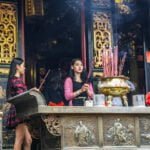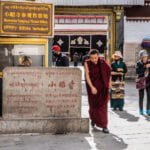Historical Significance of Nechung Temple
Nechung Temple, also known as “Nechung Drayang Ling,” གནས་ཆུང་དགོན་པ།, (乃琼寺) is a significant Tibetan Buddhist temple located in the western suburbs of Lhasa, approximately 1000 meters away from Drepung Monastery. This temple holds special importance as it is associated with the shamanic practices related to Baihar, one of the largest worldly protectors in Tibetan Buddhism. Currently, Nechung Temple serves as the seat of the Tibetan Buddhist Academy.
Key Information about Nechung Temple:
- Foundation and History: Nechung Temple has a long history, dating back to its construction in the 7th century AD. It has played a central role in Tibetan Buddhism for many centuries.
- Temple Layout: The temple features a square layout and includes various key structures such as cloisters, the main hall, side halls, and more. In the centre of the cloister courtyard, there is a Chinese-style monument, although it does not bear any characteristics. Simmering incense burners are placed on both sides of the monument.
- Shrines and Protectors: On the west side of the cloister, three columns support an earth and stone shrine. This shrine is dedicated to the deity Baihar, who is a prominent protector in Tibetan Buddhism. Additionally, the protector Ziwuma is on the east side.
- Artistic Elements: At the main entrance of the main hall, there are two Han-style stone lion statues. The walls on both sides of the main hall feature paintings of Baihar, emphasizing their significance in the temple’s spiritual life.
- Baihar Hall: One of the most renowned auxiliary halls within the temple is the Baihar Hall, located in the northwest corner of the temple complex. This hall likely holds special religious and cultural significance.
Nechung Temple stands as a testament to the rich cultural and religious heritage of Tibetan Buddhism. It is not only a place of worship but also an important centre for academic and spiritual pursuits, serving as the seat of the Tibetan Buddhist Academy.

Pehar Gyalpo. Nechung Chokyong
Pehar, also known as “Pe-har,” is a renowned protector deity in Tibetan Buddhism with origins as the patron saint of Turkic regions. Master Padmasambhava, a key figure in Tibetan Buddhism, invoked Pehar’s wisdom and invited him to serve as a protector at Samye Monastery in Tibet. Subsequently, the fifth Dalai Lama extended a welcoming invitation to Pehar, relocating him to Neqiong Temple in Lhasa. Pehar then became the primary deity worshipped by the Gelug Sect, known as the Neqiong Protector Deity.
Key Information about Pehar:
- Physical Representation: Pehar is depicted as an enraged figure with two hands. His right hand is positioned on his chest, holding a short axe, while his left hand supports a skull bowl above his head. This iconography is finely detailed and symbolizes his protective nature.
- Ancient Tree Legend: Within the temple, there is a sacred ancient tree where Baihar, believed to be an aspect of Pehar, transformed into a white dove. The ancient tree is now adorned with Hada, a traditional Tibetan ceremonial scarf.
- Shrines and Statues: Adjacent to the sacred tree, there is a shrine dedicated to Baihar, while a statue of Padmasambhava is situated on the left side. The central hall of the main temple houses the Hall of King Nechung, considered the most sacred space in the temple. Inside, there is a silver-carved Dharma throne adorned with cassocks and helmets.
- Dharma Protector Temple: In the northeast corner of the main hall, there is a separate Dharma Protector Temple that houses statues of Bandan Masojiem and Nyima Xunnu, adding to the temple’s spiritual significance.
Nechung Temple, where Pehar is honored, is described as a place of exquisite, small, solemn, and solemn reverence. It stands as a testament to the devotion and spiritual practices of Tibetan Buddhism, particularly within the Gelug Sect.
Murals in Nechung Temple
The murals within Nechung Temple, painted during the mid-17th century AD, hold a unique significance. These murals, adorning the walls of the main hall and corridors, represent a concentrated expression of the artistic style of that era. They primarily focus on depicting Baihar, his incarnations, their accompanying deities, and scenes illustrating the karmic consequences faced by sentient beings in hell due to their past misdeeds.
Key Features of the Nechung Temple Murals:
- Independent Content: The mural compositions are relatively independent, with a significant emphasis on depicting characters. The characters play a central role in conveying the narrative.
- Baihar’s Iconography: The depictions of Baihar, a prominent figure in these murals, reveal him with three heads and six arms. He wears a distinctive hat, exposing his chest and abdomen. Around his waist, there is a combination of human and tiger skin, and he adorns a necklace of human heads. His two primary hands hold a bow resembling an arrow, while the remaining four hands grasp various weapons, including a knife, sword, hook, and sword. Baihar is seated atop a green-maned lion, exuding a powerful and fierce presence, symbolizing his dominion over the three realms.
- Colour Palette: The mural backgrounds are sparingly decorated, with a predominant use of cold colours such as gold, black, and purple. These colours are vibrant, contributing to the visual impact of the paintings.
- Painting Techniques: The murals employ a variety of painting techniques, including single-line flat painting and sfumato. The use of a slightly darker colour, similar to the primary body colour, is employed for outlining the figures, adding depth and dimension to the characters.
These murals not only serve as artistic masterpieces but also hold deep religious and cultural significance within Tibetan Buddhism. They depict themes related to divine protection, spiritual transformation, and the consequences of one’s actions, offering a window into the religious and philosophical beliefs of the time.
During the Middle Ages, Tibetan art experienced its zenith and was shaped by a blend of artistic influences from different regions, including the nomadic art of the Han Dynasty, India, and Mongolia in Central Asia.
This artistic fusion is prominently showcased in the murals, capturing the distinctive characteristics of divine art.
- Nomadic Influences: The murals from this era vividly depict warriors adorned with helmets and armor, wielding weapons while mounted on horses. These depictions distinctly bear the hallmarks of nomadic art prevalent in Mongolia in Central Asia. The dynamic portrayal of armed riders reflects the influence of nomadic cultures on Tibetan art during this period.
- Indian Influence: The statues of gods and Buddhas featured in these murals, particularly the Tantric Buddha statues and Tara statues, exhibit the influence of Indian artistic styles. The artistic representations draw inspiration from the rich iconographic traditions of Indian Buddhism, reflecting the profound impact of Indian aesthetics on Tibetan art.
- Chinese, Nepalese, and Kashmiri Influences: Notably, the influence of Han Chinese art and the artistic traditions of neighbouring regions like Nepal and Kashmir is evident in the depictions of layman statues and background decorations. These elements are characterized by their elegant design, showcasing the cultural exchange and artistic cross-pollination that occurred between Tibet and its neighbouring regions.
These murals, with their diverse artistic influences and meticulous craftsmanship, represent a precious heritage of Tibetan mural art from the Middle Ages. They possess exceptional ornamental value and provide valuable insights into the artistic evolution and cultural interactions that defined this period in Tibetan history.
Pehar (pe-har) holds a significant role as a protector in Tibetan Buddhism, with varying interpretations of his status among different sects:
- Gelug Sect’s View: Within the Gelug Sect, Pehar, also known as Baihar, is regarded as the primary deity among the protector gods worldwide and is commonly referred to as “Naiqiong.” In this view, he holds a central position as a protector.
- Other Sects’ View: In the perspective of other Tibetan Buddhist sects, such as the Nyingma Sect, Pehar may hold a subordinate role among the protector gods. Different sects have their own interpretations of his status and significance within their respective traditions.
The origin of Pehar is the subject of various theories and beliefs:
- Sanskrit Origin: Some interpretations suggest that the name “Baihar” may have Sanskrit origins, possibly linked to “Vihaara.”
- Turkic Connection: Another theory connects his name to the Turkic word “Bag.” These theories provide different linguistic and cultural perspectives on his name.
One common belief is that Pehar’s lineage includes a divine father, often associated with daylight or heavenly deities, and a mother known as the Dragon Girl, symbolizing wealth and prosperity. The diverse narratives surrounding Pehar’s origins reflect the rich tapestry of Tibetan religious traditions.
Throughout his history, Pehar has been associated with various locations and titles:
- In his celestial form, he resided in the heavenly realm as Brahma, the ruler of the thirty-three gods.
- During certain periods, he was believed to manifest in the human world, taking on titles such as the “Crystal White Ghost” in Hor and the “White Life Lord” when presiding over the Badakhor local temple.
- In the 8th century AD, Zanpu Chisong Detsen and Master Padmasambhava relocated Pehar to Samye Temple in Shannan, solidifying his role as a patron saint.
- Later, during the era of the fifth Dalai Lama, Pehar was moved to the Nechung Monastery near Drepung Monastery in Lhasa and was promoted to the position of the main protector. He became known as the “King of Career” due to his specialization in matters related to one’s vocation.
Pehar’s multifaceted nature is further reflected in his ability to manifest in various incarnations, and he is sometimes referred to as the “Five Body King” in the Gelug Sect. This versatility allows him to fulfill his protective duties and overcome obstacles to Buddhism in the Tibetan snowy regions effectively.
In summary, Pehar’s role and significance in Tibetan Buddhism vary across sects and traditions, showcasing the diversity of beliefs within Tibetan Buddhism.

